This post is part of a larger deep dive
Curious about the role of engrams in To the Moon? Check out To the Moon Explained!
Or read the full To the Moon article!
This post is part of a larger deep dive
Curious about the role of engrams in To the Moon? Check out To the Moon Explained!
Or read the full To the Moon article!
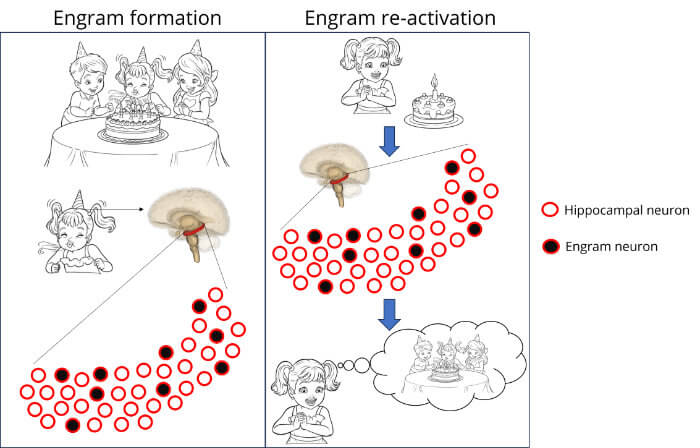
Have you ever stopped to think about how do you actually remember things?
Think of your last birthday. Obviously, you aren’t literally reliving your birthday when you remember having met your friends and family and eating cake. So, what exists in your brain that allows you to have such a vivid mental image of that experience?
Strides have been made to answer questions like these, and research has unambiguously led to a particular construct: the engram.
To me, engram research is one of the most exciting topics in the field of neuroscience. Simply put, the engram is a neuronal representation of a particular experience.
More specifically, whenever you experience an event, that experience activates a bunch of neurons that encode that event in the brain. These neurons go through chemical and physical changes (e.g, strengthening of synaptic connections among neurons), forming what scientists refer to the “engram” – the physiological substrate of the memory itself.
Note that the engram is not synonym with memory. It simply provides the scaffold for a memory to emerge.
For example, a cue present during the encoding of the experience (e.g., seeing a birthday cake) can potentially reactivate the engram; only then will the memory of that experience (e.g., your birthday) be retrieved.

To understand how scientists have been able to observe engrams, it will be useful to explain a particular experimental set-up researchers use called the fear conditioning paradigm.
In this paradigm, researchers condition mice by repeatedly playing an innocuous stimulus, for example a neutral tone (what is known as conditioned stimulus, or CS) at the same time they deliver an aversive stimulus, such as a footshock (what is known as unconditioned stimulus, or US). The unpleasant footshock causes mice to freeze, which is an adaptive defense mechanism in prey animals.
By repeating this process a number of times, the mice will learn to associate the innocuous tone with the unpleasant shock, and a new associative memory (CS-US) will be formed.
After fear learning training, playing the tone in isolation (i.e., without the shock) is typically sufficient to see mice freeze in fear, showing that the new associative memory during the previous learning phase (i.e., the CS-US memory) has been retrieved.
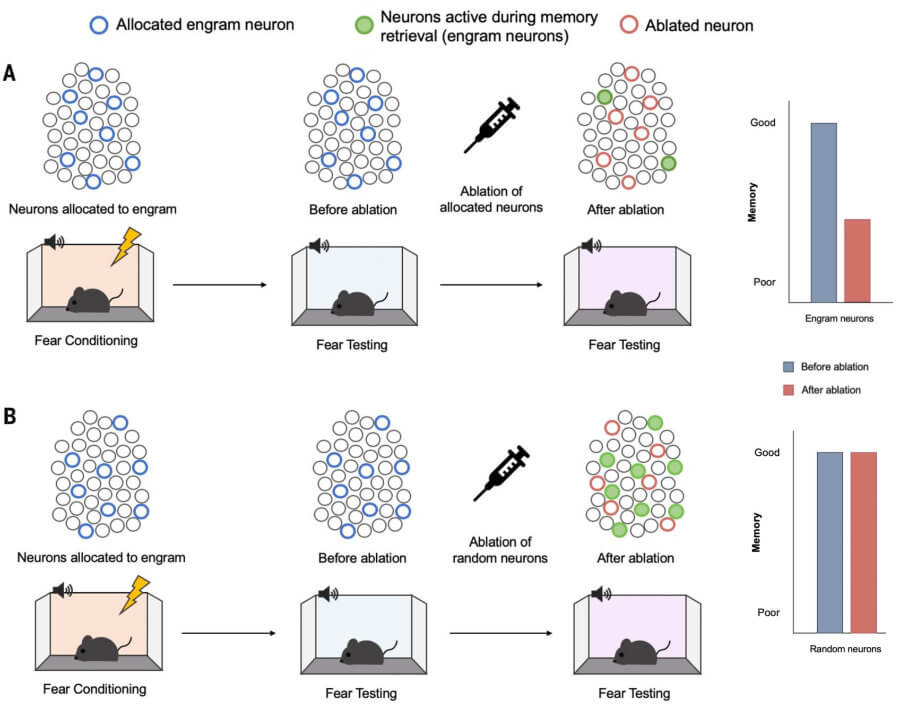
Now, for the most part, engram research has been conducted using rodents.
In one study, researchers tagged neurons that were active during the fear learning training. They found that there was an above-chance overlap (about 11% overlap in the basal nucleus of the amygdala) between those neurons and neurons active when mice were re-exposed to the same conditioned context 3 days later.
Researchers have also been able to manipulate which neurons will be part of an engram. In one study, a number of neurons were selectively allocated to an engram in mice while they performed the fear learning task. The mice showed the typical freezing in response to the CS alone.
Afterwards, those allocated engram neurons were eliminated (ablated). When the mice heard the CS tone again (which should have evoked the fear memory), they did not freeze. It was as though the fear memory had been completely erased.
To ensure that the lack of freezing response wasn’t just a general insensitivity, the researchers then killed a bunch of random neurons (those not allocated to the engram). Mice showed the typical freezing behaviour when the tone was replayed, suggesting that the disruption in the freezing behaviour mentioned above was specific to the elimination of allocated engram neurons.
You might have already heard or read somewhere that many algae and bacteria have photo-sensory molecules that can convert light into electricity.
Even humans do it to some extent. For example, our vision is possible due to the presence of a type of opsin protein (called rhodopsin) found in the rods of the retina. Light reaching your eye is converted into an electrical signal which is transmitted to the brain, allowing us to see.
Scientists have taken some of these natural proteins that can convert light into electricity, and manipulated them so that they can be inserted into neurons.
In most cases, the protein channelrhodopsin (ChR) is used, which is present in green algae and is sensitive to blue light. Thus, if a neuron contains ChR, blue light would stimulate that neuron.
In order to place ChR into a neuron, we need a bit of genetic engineering; that is, we change the genetic makeup of the neuron, such that it expresses ChR. To that aim, viruses can be used to infect the neuron and change its genetic expression in order to produce light-gated ion channels that react to light.
Once this has been done, if you shine light into those neurons, the light gets converted into electricity. Because neurons use electrical signals to function and send messages to other neurons, we can use light to turn on/off those neurons at our leisure.
Conversely, scientists can also inhibit, or silence, the neuron by exposing other types of protein to light (e.g., Archaerhodopsins).
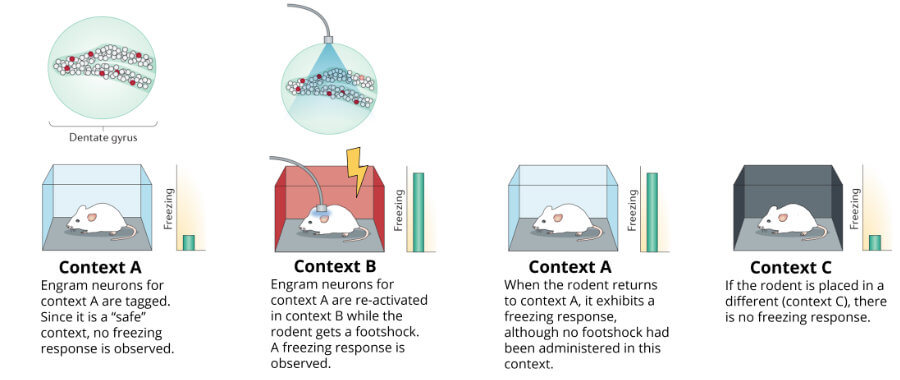
The studies I reviewed above suggest the existence of engrams for actual experienced events.
But what if we could make use of engrams to generate memories of events that were not experienced by the subjects? In other words, can we implant false memories?
Recent optogenetic studies (see What is optogenetics?) on mice appear to suggest we can.
For instance, a team of researchers from MIT published a study in 2013 in the journal Science in which they let mice explore a particular environment (context A), while the researchers labeled engram neurons in two regions of the hippocampus (dentate gyrus and CA1; see figure above).
Then, the mice were put in a different environment (context B), where researchers administered uncomfortable footshocks. Critically, during this fear learning training, the researchers reactivated the engram neurons in the two hippocampal regions that had previously been labeled in context A. Reactivation was performed using optogenetics, a technique which uses light to activate specific neurons.
Next, the mice were placed back in context A, where, remember, no footshock had been administered.
What do you think happened?
Even though mice were never shocked in context A, they still froze in fear significantly above chance as soon as they were placed in context A.
Say what?!? Why would the mice freeze in the context that was completely safe??
The answer is that the activation of the engram linked to context A got associated with the shock during the fear learning phase in context B. So the mice formed a false memory: the memory that context A should be feared.
Importantly, when the mice were placed in a novel context (context C), they did not show above-chance levels of freezing behaviour, suggesting that the false fear memory was restricted to context A.
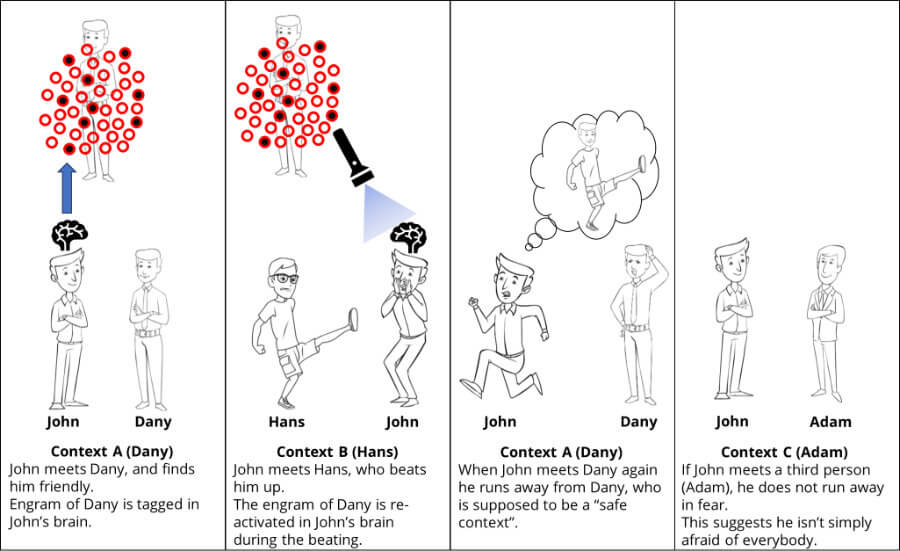
Let’s make this a little bit more tangible by imagining that, unbeknownst to you, you are the subject of a wicked experiment by a wicked scientist.
The scientist introduces you to Dany, who is friendly to you, making you feel safe around him. During this interaction with Dany, the scientist records your neuronal activity, and detects a collection of neurons that visually represent Dany.
Later, the wicked scientist introduces you to another person called Hans. Now, Hans is barbaric beyond belief, as you get repeatedly punched and kicked by him.
Now, while Hans is beating you up, the wicked scientist activates the previously recorded neuronal representation of Dany in your brain. The consequence is that you become convinced that Dany is physically attacking you.
When the wicked scientist places you together with Dany again, your behaviour is to immediately wet your pants. The reason should be obvious: you got beaten up pretty badly and, in your mind, that was the doings of Dany.
But, the scientist ponders, perhaps this has nothing to do with Dany specifically; maybe you are simply generalising your fear to pretty much every human being. To figure this out, the wicked scientist sets you up with another individual, Adam, who you appear not to fear.
The results of this experiment show that the wicked scientist has successfully implanted in your brain a false memory of Dany (and not any other person) as being the aggressor.
This is pretty much what researchers did to the mice (just not so violently as in my made-up and cruel experiment). Dany would be context A, Hans context B and Adam context C. The neuronal representation of Dany that the scientist tagged in your brain would be like the neuronal engram that was labelled in the brains of mice during the exploration of context A. And the beating would be the footshock.
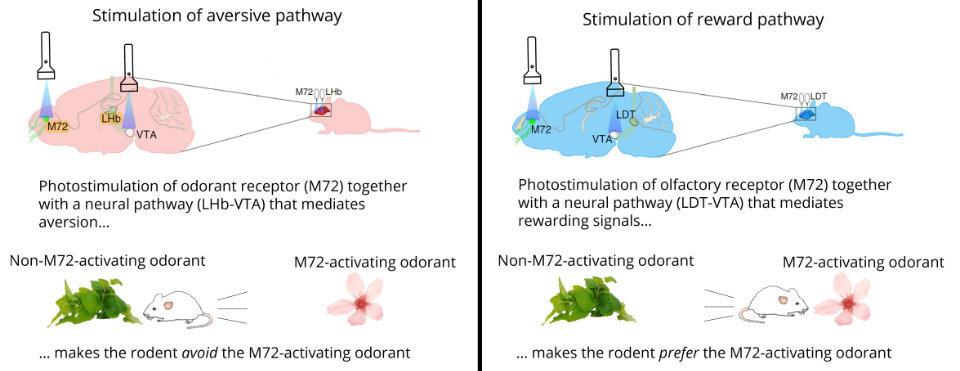
In all the studies I reviewed above, the mice underwent some sort of learning experience; even in the false memory study, mice were physically shocked in a particular environment.
Impressively, a more recent study showed that artificial memories can be made even in the total absence of experience.
Researchers used optogenetics (see What is optogenetics?) to stimulate a structure in the olfactory bulb, a brain region involved in the sense of smell, in the mice’s brain. Importantly, that brain region responded to a particular type of odor called acetophenone. This stimulation was paired with optogenetic stimulation of neuronal populations involved in either rewarding or aversive responses (see figure above).
After conditioning, mice showed a preference for the real odor when the rewarding pathway had been stimulated (right figure above), whereas they showed aversion to the odor when the aversive pathway had been stimulated (left figure above).
Remember, mice did not undergo any task or experience whatsoever, they sat idling in the lab. So the memory the researchers created was indeed fully artificial.

If engrams are damaged, they cease to exist. In that case, it will not be possible to access the memory ever again. Damaged engrams can result from traumatic injuries to relevant brain regions that encode said engrams.
On the other hand, if engrams are simply temporarily inaccessible, they will still exist, but cannot be retrieved by natural retrieval cues. These inaccessible engrams are called silent engrams.
For instance, one study showed that administering a drug that inhibits protein synthesis right after fear learning, disrupted the freezing response in mice tested 1 day later. However, the fear memory returned if engram neurons that had been tagged during fear conditioning were reactivated with optogenetics (see figure above).
This research has natural and important clinical implications in the understanding of memory disorders such as Alzheimer’s disease. The most pressing question is: are engrams in these memory ailments forever lost, or are they simply inaccessible in the sense they cannot be re-activated by natural means?
The jury is still out there.
Lovely article 🙂
Hi Ewan,
Thank you very much for your comment – I’m happy you enjoyed the article! 🤗